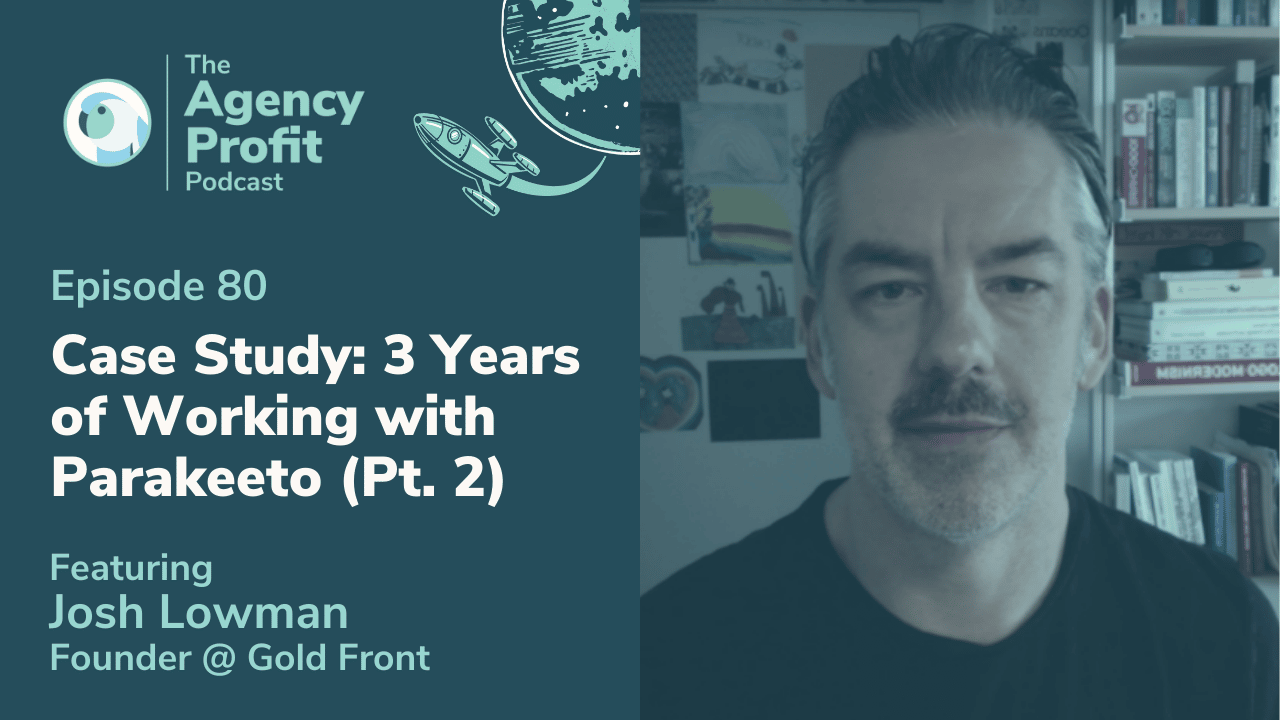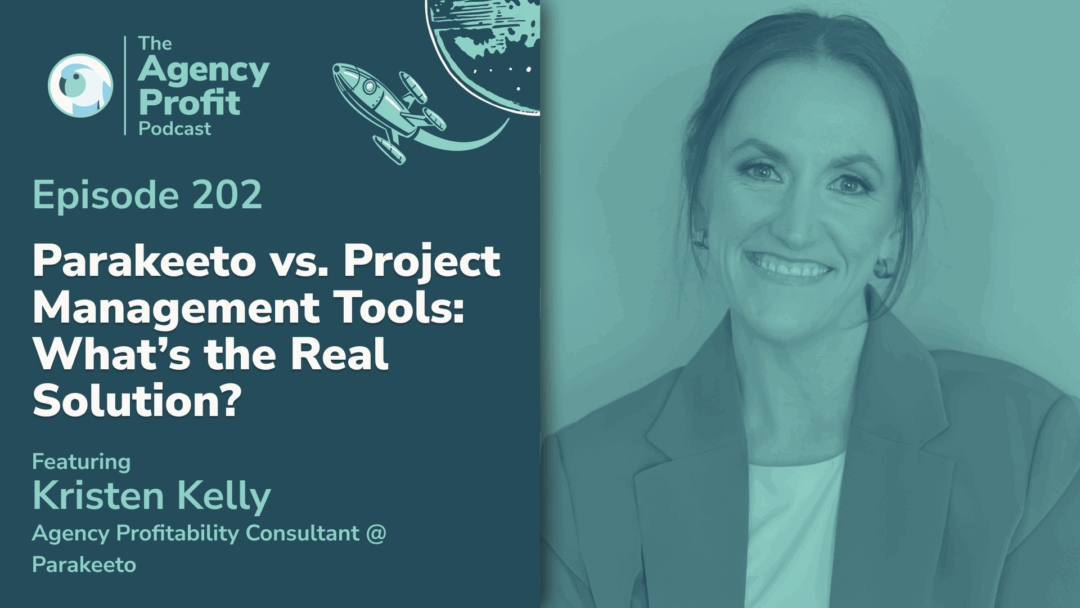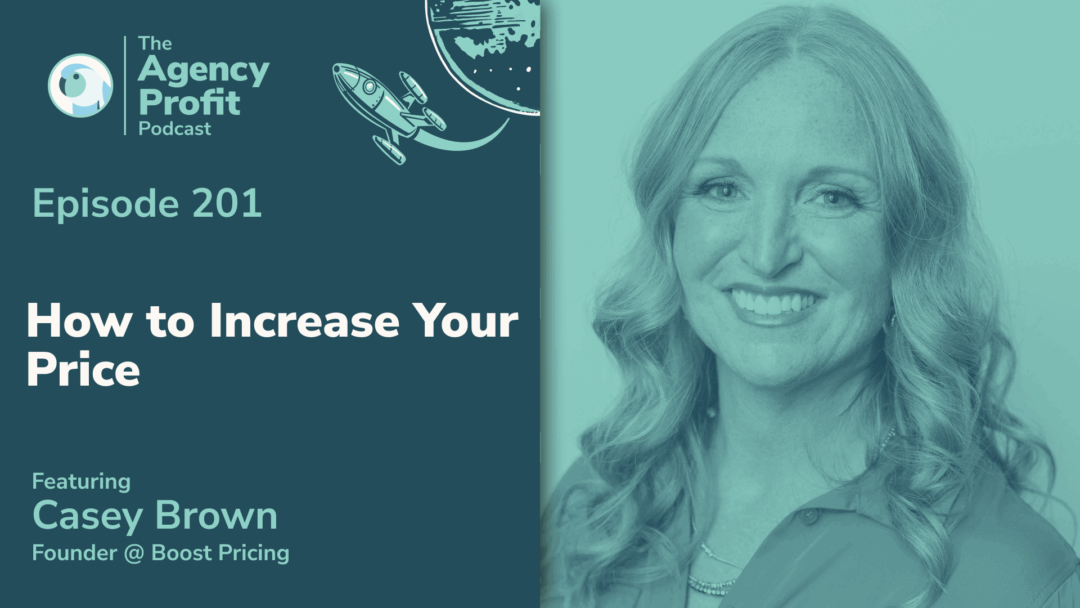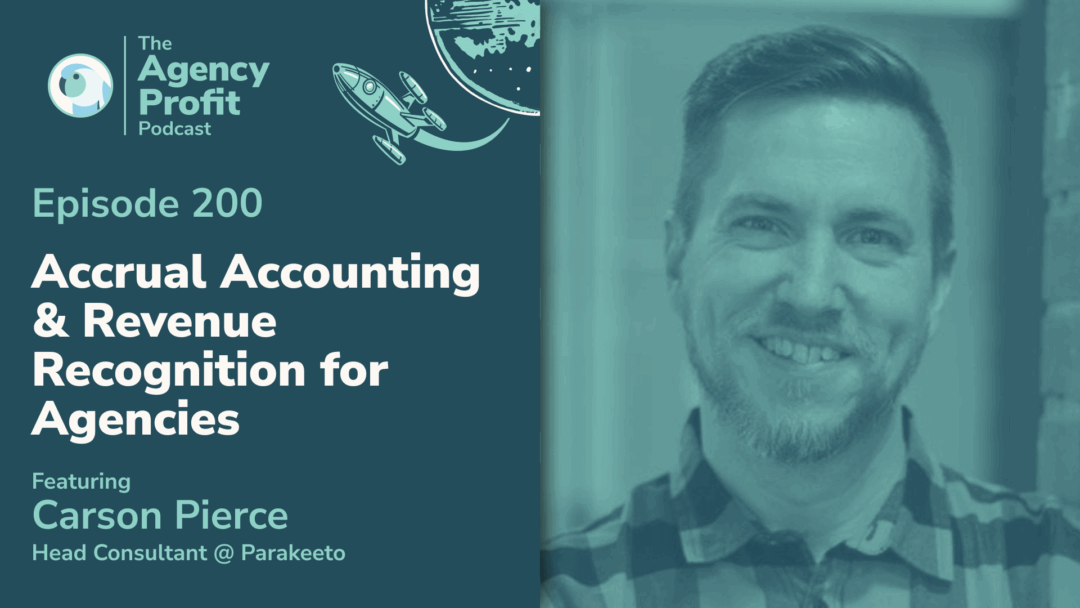As promised, here is Part 2 of our case study featuring Josh Lowman of Gold Front. Josh and I have joined forces to examine the last three years working in tandem, which have been quite the ride – hence the two installments!
In part one, we talked about how Josh figured out that he needed help in his agency with profitability, how he came to that conclusion, how he found us, and the origin story of us working together. In this second part, we’re going to unpack some of the things we’ve encountered, the major milestones, the progress we’ve achieved, and some of the mindset shifts that have occurred along the way.
About Josh Lowman | Gold Front
As you may recall from our previous episode with Josh, he is an incredible creative director and entrepreneur. As Founder and Chief Creative Officer at Gold Front, he’s a long-term client of Parakeeto,
A category design studio, GF is based in SanFran but also has other locations strewn across America. Their primary goal? To help growth-stage startups define and own their own category.
How did Josh get into this space? Well, Gold Front started as a Brand Studio before branching out into Category Strategy, with Josh then realizing the need to combine Brand Execution with Category Creation Strategy. This has led to collaborations with Uber, Robinhood, Newsela, plus oodles more to build category-defining brands.
When John isn’t changing the branding landscape, he’s enjoying downtime with his wife, daughters, and his dog!
Points of Interest…
- The Current State of Gold Front 1:21
- Metrics that Provided Effectiveness 5:56
- Accurately Calculating Effectiveness 10:07
- Josh Turns the Tables on Me… 14:13
- Challenges in the Partnership 16:35
The Current State of Gold Front
By way of a recap; Josh and I met a little over three years ago, Gold Front is doing $1.4 million in revenue, profitability is somewhat unclear at that point – a little bit hectic, a little bit uncertain. So, how would Josh describe the state of Gold Front today? What does that look like?
“Profitability was probably 10% to 15% at the time. It was just a way for me to pay my salary and have a little extra money at year-end. Since then, it’s kind of gone way beyond my wildest dreams at this point!”
In 2019, Gold Front grew by probably 45%. In 2020, it grew 56%, and at the time this recording took place, the company was on track to grow about 90%. Now, alongside Head of Growth, Liston Witherill, Josh is enjoying being engaged in the sales process more.
Some of that growth has been the result of simply having much better systems in place in order to maintain and scale a reliable business. Additionally, about a year ago, Josh and his team reinvented the agency as a Category Design Studio, working alongside David C. Baker with positioning Gold Front’s category. That, combined with the onboarding of Liston, was a source of “rocket fuel” for the company.
“Startups, VCs, and private equity firms now know about us. They know we’re a Category Design Studio and that’s something kind of special – we’re fulfilling a really important need in the market.”
As for Gold Front’s profit margins today? Well, without delving into specifics, it’s effectively “multiples above” what it was when Josh and I first met. And this means lots of things; for starters, it means Josh can support his employees much more, both financially and on an emotional level. ***He discusses this further from 4:23 minutes***
Metrics that Provided Effectiveness
I want to dig into some of the more important metrics that Josh is now able to see, and some of the changes he has since in his day-to-day to aid decision making. At a mature level, what does that level of insight look like?
“The first thing we talk about is utilization, and making sure that our company as a whole is at least 65% utilization. That includes people who are non-billable as well – so that’s the entire agency. That’s REALLY important; that’s the sort of thing that is foundational.”
Another thing that is foundational is your ABR (Average Billable Rate) and making sure that that’s growing or high enough to sustain the costs that you have and be profitable. Additionally, since our collaboration, Josh has really appreciated this idea of effectiveness.
It’s around the idea that ‘Hey, there’s a certain amount of revenue that we could earn in a week. And if we look at our accrual basis for that week versus how much capacity we have for that week – that is a percentage. That’s a more direct measurement of how the business is doing for that week. That is effectiveness.
My thesis is, you should never look at utilization and average billable rate individually, rather always look at them TOGETHER. That way, you can just trade costs off on each other. Like your average billable rate could go up, but then your utilization goes down, and vice versa.
Effectiveness is the financial combination of those two concepts in a single metric that tells you the whole story, which is what makes it so powerful. It took a while for Josh to initially come around to the idea, however… ***We dive further into the effectiveness of effectiveness (apologies) from 8:57 minutes***
Accurately Calculating Effectiveness
What I most enjoy about effectiveness is that it’s a conduit; a forcing function to enable us to become more sophisticated regarding the way accrual revenue is being calculated at Gold Front – which is very advanced at this point. We’re able to see the value of the work that is theoretically getting earned on a day-to-day basis.
The drive to refine that process came from being able to accurately calculate effectiveness. It might be a “simple” metric, but it’s not an easy metric – because you must have really good capacity modeling, which is complex in and of itself. Then, you must have a great system for deciphering your curls on a relatively tight timeline – so, in short, it forced us to really improve the way myself and Josh did those two things!
Today, it enables us to predict the future, getting a better understanding by observing our project profitability report, looking at the revenue forecasts, and using that to think about where best to focus your attention. So, how does Josh forecast?
“We’re at two places where we can do projections. We use 10,000 Feet – and that’s more around resourcing and getting specifics into people, projects and things like that. Then we have a spreadsheet we call the Project Profitability Report, in which there’s a visualization of the overall total revenue we’ve booked in the past and also in the future.”
The benefit of this is; if you’re in the sales process and have a potential project that may close in the next week or two, you can toggle that one on and see what that does to your capacity. You can see the capacity of your entire agency, not just by team.
***Josh provides a radical analogy regarding when to forecast the best time to hire/best time to focus on sales from 12:03 minutes***
Side Note: The simplest way to model capacity is often to create a “payroll grid”. This means listing all of your delivery and partial delivery employees, along with their weekly capacity and then multiplying that by the number of weeks in a given period.
Want to set benchmarks for your team and agency around utilization? You’d then add delivery/billable expectations and time off / holidays to that grid and model out your capacity and utilization targets for the team.
Example:

Want this exact payroll grid template? It’s included for free in our Agency Profitability Toolkit:
Josh Turns the Tables on Me…
Around this point (14:13 minutes to be exact), Josh takes hold if the reins, asking me what was going on in my life when we first met three years ago. And, to be honest, at the time we still believed we were going to solve this agency profitability metrics problem, purely with software. We were going to be a SaaS company.
Looking back, it’s quite amazing how much of the constraint we were putting on the business was completely arbitrary – it was born from our own insecurity. While we won’t unpack the psychological ludicrously of why we were doing that to ourselves, we can try boil it down to a certain naivety. Not all things can be solved by software alone, it’s more nuanced than that. Plus, the product was really tricky to build.
The rubber inevitably hit the road when our investors called to say “Hey, you’re going to run out of money soon. What’s the plan?” And then the “plan” became what we do today – we sell consulting. We’re just going to start helping agencies solve this problem.
Getting that hands-on experience was, and still is, a great way to learn and figure out how to build a better product – while getting paid to learn along the way! So, basically, we turned the funnel for the product into the funnel for consulting.
Challenges in The Partnership
Listen, we spend a lot of time here talking about the wins, the successes, and the path to glory. Um, but I think it’s important that we double back and clarify some of the things that have been hard about this. To clarify, what Parakeeto and Gold Front have accomplished together over the last few years has not been straightforward.
I’m keen for Josh to share what he found most challenging en route to where we are today.
“The biggest things was that counterintuitive way of thinking; you think you’re maxed out in what you can do – and then adding something new to that seems more than what’s possible. What I really needed to do was just find some things that I could let go of… one of the hardest things about being a business owner for me is figuring out what’s the small stuff that I can let go of.”
And in terms of us working together?
“It’s kind of been really easy… I’m kind of a creative at heart. I never thought that I’d have an agency where we have Standard Operating Procedures, all written out. And this is exactly how we do things because I would’ve thought that’s too corporate. So, there’s been cultural shifts.”
If somebody was listening/reading, and they’ve been considering reaching out to Parakeeto for help with operations and profitability, what would Josh say to them in that moment?
“One of the key things is that you guys specialize in this, and you do it over and over again, it’s like so many of those things are gonna, you’re gonna kind of see the same thing in almost every agency. You’re getting true expertise with you guys. Overall, it’s just been an amazing experience”
And there’s no better way to end a show, so we’ll leave it at that!
Key Takeaway…
You can have process and you can do things by the book, but you don’t have to be bureaucratic and corporate – it’s possible. Be process-oriented and still a cool human company!
If you have learned something from this, you got an insight, please reach out and let us know, leave a comment – or reach out to me, send us a note – we always love to hear from you and what you’re getting from the show.
See more from Josh…
- Gold Front
- Twitter @JoshLowman
- LinkedIn @JoshLowman
- Company LinkedIn @gold-front
- Company Twitter @GoldFrontSF
Did you learn anything new from this episode? Let us know in the comments below! We have helpful blogs designed to bolster your agency profitability, such as How To Calculate Your Billable Employee Cost-Per-Hour.
Our next installment of #APP, on February 23rd, will see Marcel chat with Russell Benaroya. Part 1 of our Gold Front/Parakeeto Case Study with Josh Lowman is here…
Agency Profitability Tool Kit
If you’re looking for more resources to help you improve your agency’s profitability, check out the Agency Profitability Tool Kit. It’s full of templates and checklists used when consulting clients. This helps them improve profitability by over 100% in under 60 days.








0 Comments